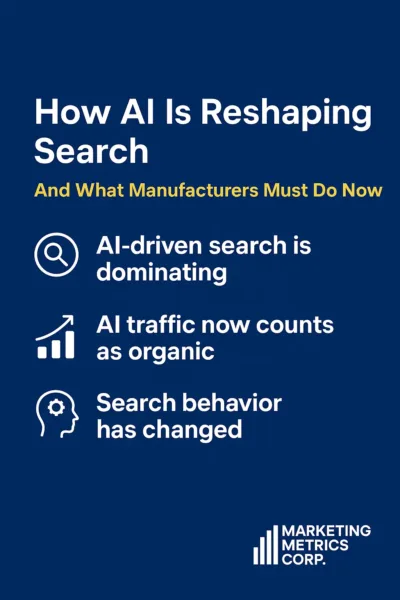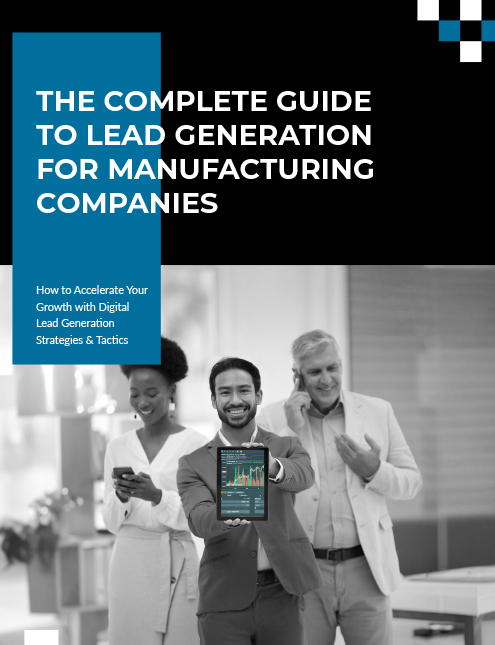How AI Is Reshaping Search – And What Manufacturers Must Do Now
Introduction
The way people search has changed. Has your search optimization strategy changed yet? As an industrial marketer, you need to pivot and catch up fast with the changing face of online search.
AI SEO is powered by tools like Google’s AI Overviews (an AI-generated summary feature at the top of some Google searches), ChatGPT, and Perplexity that have already delivered more than 2.5 billion search results without a single click. That means your customers are finding answers before they ever reach your website.
If AI is guiding their journey, is your company even showing up?
In today’s industrial B2B space, relying on traditional SEO alone won’t cut it. To stay visible and competitive, your digital strategy must evolve to meet the new rules of AI optimization-driven discovery. Are you ready to adapt, or are you at risk of falling behind?
Key Takeaways
- AI-driven search is dominating – Tools like Google AI Overviews, ChatGPT, and Perplexity are delivering billions of answers without clicks. If your content isn’t optimized for AI, you risk being invisible.
- Ai traffic now counts as organic traffic – As of June 1, 2025, Google Analytics attributes AI-generated traffic properly, meaning you can now measure its impact on leads and RFQs.
- Search behavior has changed – Over 60% of searches result in zero clicks. To win visibility, your content must surface inside AI-generated answers, not just on Google’s SERPs.

The June 1 Shift: AI Traffic Is Now Counted as Organic
Until recently, traffic from AI Overviews, i.e., clicks from search summaries, citations, and AI answers, was miscategorized in Google Analytics 4 (GA4) as direct or referral traffic.
Now, as of June 1, 2025, that traffic is finally being properly attributed to organic search. This reclassification validates what many marketers have suspected: AI is already driving meaningful traffic and leads; now we can prove it.
For manufacturers, this means you can now clearly see how AI-powered search is impacting your inbound inquiries and RFQs. If your product pages and technical content are optimized for AI visibility, you’re more likely to capture high-intent buyers and specifiers earlier in their journey.
Search User Behavior Has Changed Dramatically
Over 60% of searches now result in zero clicks. Users conduct 3+ searches on average before engaging. Click-throughs are rarer and more valuable than ever.
This behavior shift is a direct result of AI Overviews. Your content must be structured to show up within the AI response itself. Without AI optimization, you’re invisible.
Google Is Losing Its Grip, And That’s a Big Deal
According to recent estimates, Google’s search engine market share has dipped below 90% for the first time in decades. Users are starting searches directly inside AI tools like ChatGPT, Perplexity, Claude.ai, and Gemini.
Users like these tools because they make search activity so much faster and more efficient by delivering synthesized answers. If your content isn’t optimized for AI parsing, or you’re not showing up in reputable citations, it’s akin to installing a neon sign deep in the woods – nobody will see it!
But despite the growing popularity of AI tools, recent earnings suggest that Google isn’t fading – it’s adapting. In Q2 2025, Google reported a 14% revenue increase, driven largely by AI-powered features like AI Overviews in Search and strong performance in Google Cloud, as reported in a recent article in The Wall Street Journal. Rather than cannibalizing its core business, AI is actually helping Google drive more engagement and revenue, reinforcing its dominance even as the search landscape evolves.
AI SEO for Manufacturing Marketers – Time is of the Essence
AI optimization of digital content isn’t just a tech trend. If you are a manufacturer who relies on complex sales cycles, technical buyers, and high-value leads, AI optimization is mission-critical.
Key steps to get started right away
- Create content that matches how AI tools think: AI-driven platforms don’t just scan for keywords; they also analyze intent, context, and structured responses. Produce content that clearly answers questions, explains technical specs in plain language, and aligns with how AI interprets user queries.
- Implement llms.txt: Adding an llms.txt file to your site helps large language models (LLMs) understand what content they can safely use for AI-generated summaries. This gives your manufacturing business greater control over how your expertise is presented in AI Overviews and voice searches, ensuring the right information reaches potential buyers. Note: While llms.txt improves transparency, AI tools may still reference or learn from publicly available content.
- Build author bios and thought leadership: Search engines and AI SEO tools prioritize content backed by credible, human experts. You can build trust within the industrial user community by showcasing engineers, quality specialists, and product managers as authoritative voices through well-crafted bios and bylines.
- Use structured data: Structured data (schema markup) helps AI and search engines understand the specifics of your content, whether it’s technical documentation, product specs, or CAD files. As a manufacturing company, this can increase the visibility of your key product attributes and certifications in AI-generated answers.
- Get off-site credibility: Mentions, backlinks, and reviews from reputable industry sites, trade publications, and supplier directories strengthen your domain’s authority. This tells AI systems that your manufacturing business is a trusted source, increasing your chances of being referenced in summaries and answer boxes.
- Format for fast value (TikTokification): All buyers, even technical users, want efficiency. It helps to make key information scannable and digestible in seconds. Break up your digital content with bullet points, visuals, and clear subheadings so AI (and humans) can extract meaningful value quickly without scrolling through jargon-heavy text.
What’s the Difference Between AI SEO and Traditional SEO?
Traditional SEO focuses on keywords, meta descriptions, and link building. AI SEO focuses on semantic relevance, authority signals, and fast, high-value answers. The important thing to note is that it isn’t an either/or situation. You need a good balance of both.
Together, these approaches form a modern content optimization strategy that spans traditional search and emerging AI SEO discovery platforms.
Tools and Reporting: What to Track
You can measure AI optimization impact using tools like SEMrush, SimilarWeb, and SERP APIs. Include estimated paid value of AI visibility and citation tracking in monthly reporting.
AI Optimization Is Urgent, and It’s Not Optional
AI is reshaping how people find, trust, and act on information. In your field of manufacturing, the time to adapt is now.
5 Steps to Implement This Quarter:
- Audit your site for AI SEO readiness
- Create awareness-level content
- Implement llms.txt: This file helps large language models (LLMs) – like ChatGPT – understand which parts of your content they’re allowed to use.
- Publish authoritative blog content
- Monitor AI traffic in your analytics
Need Help Getting Started with AI Optimization?
At Marketing Metrics, we help manufacturers stay ahead of digital trends. We speak the language of engineers, procurement teams, and sales reps, and we know how to translate that into content that AI engines trust.
Let’s talk about how you can turn AI search into real results 🚀
AI SEO FAQ for U.S. Manufacturers
What is AI SEO and why does it matter for manufacturers?
AI SEO focuses on optimizing your website so AI-powered tools like Google AI Overviews, ChatGPT, and Perplexity can find, understand, and cite your content. For manufacturers, this is critical because engineers, procurement teams, and buyers now rely on AI-driven search to make purchasing decisions.
How is AI search different from traditional Google search?
Traditional SEO focuses on ranking in Google’s results. AI search goes further — users are increasingly finding answers directly inside AI summaries, citations, and chat-based tools. If your content isn’t optimized for AI, you may not appear where buyers are looking.
How can manufacturers optimize content for AI search?
To optimize for AI search, focus on structured, high-value content: answer technical questions clearly, use schema markup, create expert-driven author bios, and implement an llms.txt file. These steps help AI tools better understand and cite your expertise.
How do we track AI-driven traffic?
As of June 1, 2025, Google Analytics 4 now attributes AI Overviews traffic as organic search. You can also monitor citations, backlinks, and impressions from AI tools using SEMrush, SimilarWeb, and SERP APIs.
How can AI SEO help generate more leads?
By appearing in AI-powered results and citations, your manufacturing company reaches buyers earlier in their decision process. This visibility drives more qualified traffic, RFQs, and high-value leads directly from AI-driven search channels.

The Complete Guide to Lead Generation for Manufacturing Companies
10 ways to generate leads for your manufacturing business
Inbound marketing tactics
Outbound or account-based marketing & sales tactics
Ways to capture contact information from website visitors
Technologies that support lead generation and revenue growth






